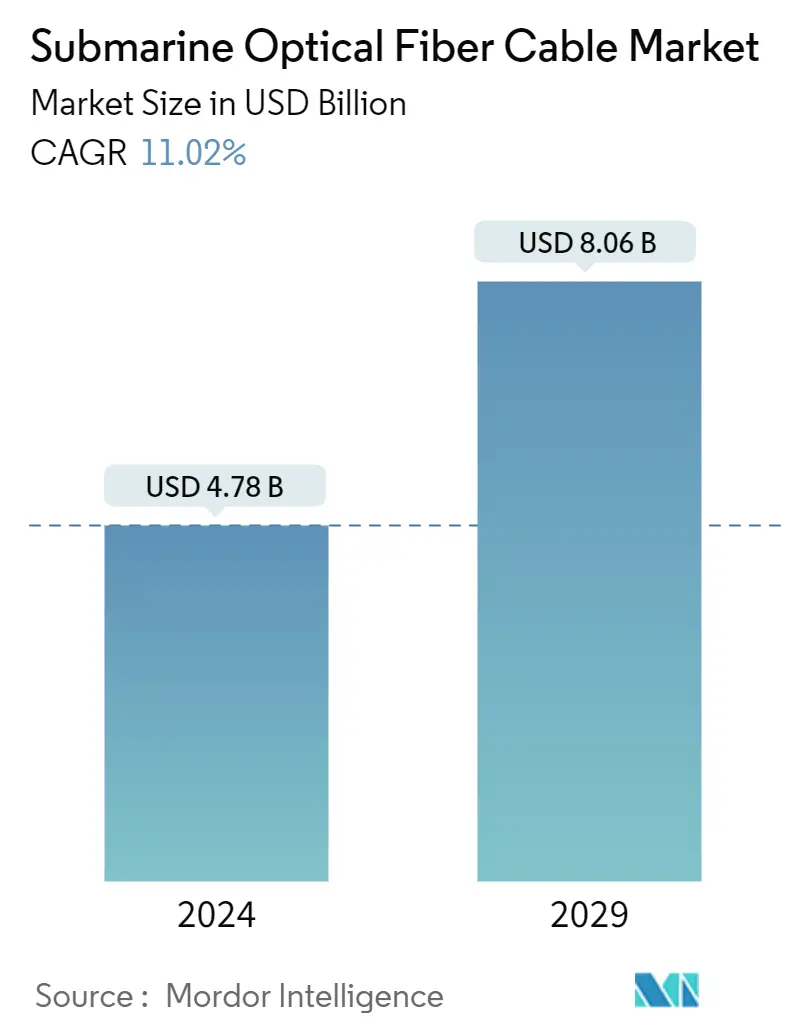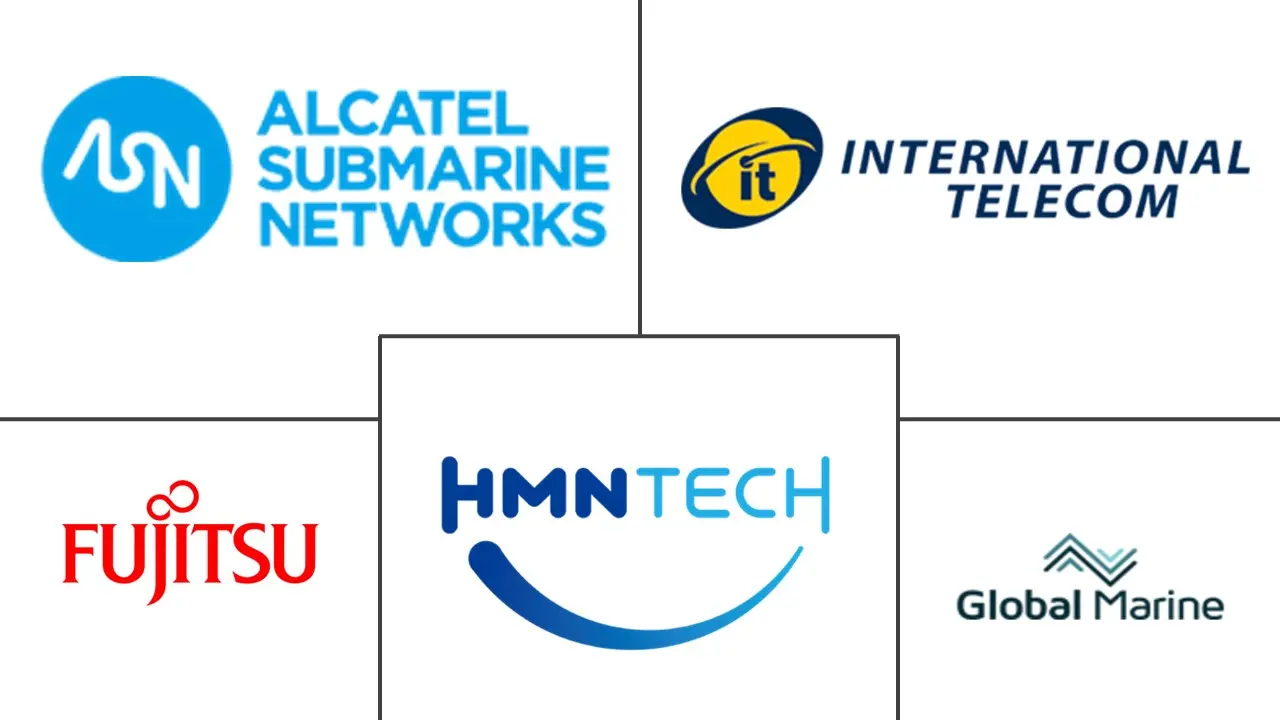Market Size of Submarine Optical Fiber Cable Industry

| Study Period | 2019 - 2029 |
| Base Year For Estimation | 2023 |
| Market Size (2024) | USD 4.78 Billion |
| Market Size (2029) | USD 8.06 Billion |
| CAGR (2024 - 2029) | 11.02 % |
| Market Concentration | Low |
Major Players
*Disclaimer: Major Players sorted in no particular order |
Submarine Optical Fiber Cable Market Analysis
The Submarine Optical Fiber Cable Market size is estimated at USD 4.78 billion in 2024, and is expected to reach USD 8.06 billion by 2029, growing at a CAGR of 11.02% during the forecast period (2024-2029).
Growing investment in high-speed internet infrastructure is one of the major factors driving the growth of the submarine optical fiber cable market. The continuous increase in the generation and transfer of vast amounts of data worldwide is one of the primary drivers of the market. Hence, many internet backbone operators will invest in the submarine optical fiber cable market during the forecast period.
- Global offshore wind power growth is expected to fuel market growth. The Global Wind Energy Council (GWEC) has stated that the United States is among the largest offshore wind markets. However, countries like the United Kingdom, Germany, China, Japan, and Taiwan are investing significantly in developing their offshore wind energy industry, creating a favorable scenario for market growth.
- With the rapid growth of data usage worldwide, there is an increasing demand for low-latency, high-capacity communications infrastructure. Submarine under Sea Optical fiber cables have emerged as a preferred solution to address the need for high-capacity, low-latency communication infrastructure.
- Fiber optics provide a more dependable, faster, and higher bandwidth mode of data transfer than traditional lines used by most utilities. Submarine Fiber optic networks send data by pulsing light via glass fiber strands approximately the size of human hair. When digital signals are sent via light, there is no external interference and reduced signal loss. This results in a more dependable data transmission network across vast distances. Furthermore, as these networks expand, user traffic continues to rise, necessitating the creation of standardized fiber testing procedures.
- The higher maintenance cost associated with the submarine optical fiber cable is analyzed to restrain the submarine optical fiber cable market growth, as the laying and maintenance of submarine fiber optical cables require a massive amount of human and material resources, including ships, divers, laying equipment, etc. This translates to a high cost of laying, repairing, and maintaining submarine optical fiber cables.
- The expansion of the world economy directly impacts the need for submerged optical connections. Expanding economies necessitate increasingly extensive undersea cable networks due to the need for high-speed internet connectivity. For instance, according to the World Bank estimate, the North American GDP, which was USD 32.32 trillion in 2023, is predicted to increase by 1.5% in 2023-24, suggesting that corporate activity and possible submarine optical fiber cable investments are projected to flourish.
Submarine Optical Fiber Cable Industry Segmentation
A submarine optical fiber cable is laid beneath the sea on the seabed. These cables carry telegraphy traffic at the initial stages of application. However, with technological advancements, the next generation of these cables carry telephone and data communication traffic. Currently, cables use optical fiber technology to carry digital data, viz., the internet, private data traffic, and telephones.
The submarine optical fiber cable market is segmented by geography (Trans-Pacific, Trans-Atlantic, United States-Latin America, Intra Asia, Europe-Asia, and Europe-Sub-Saharan Africa). The market sizes and forecasts regarding value in (USD) for all the above segments are provided.
| By Geography | |
| Trans-Pacific | |
| Trans-Atlantic | |
| United States-Latin America | |
| Intra-Asia | |
| Europe-Asia | |
| Europe-Sub Saharan Africa |
Submarine Optical Fiber Cable Market Size Summary
The submarine optical fiber cable market is poised for significant growth, driven by the increasing demand for high-speed internet infrastructure and the rapid expansion of data usage globally. As internet traffic continues to surge, submarine cables have become essential for providing low-latency, high-capacity communication networks. These cables, which transmit data via light pulses through glass fibers, offer superior reliability and bandwidth compared to traditional communication methods. The market is further bolstered by the growth of offshore wind power and the expanding smartphone industry, which necessitate robust digital infrastructure to support the burgeoning data consumption and connectivity needs.
Despite the high maintenance costs associated with submarine optical fiber cables, the market is expected to expand due to the growing economic activities and the need for extensive undersea cable networks. Key players in the industry are actively investing in advanced technologies and strategic partnerships to enhance their offerings and maintain a competitive edge. Notable developments include the deployment of high-capacity optical solutions and the construction of new cable systems to improve global connectivity. These advancements, coupled with increasing smartphone penetration and the demand for reliable communication infrastructure, are set to drive the market's growth over the forecast period.
Submarine Optical Fiber Cable Market Size - Table of Contents
-
1. MARKET INSIGHTS
-
1.1 Market Overview
-
1.2 Industry Attractiveness - Porter's Five Forces Analysis
-
1.2.1 Bargaining Power of Suppliers
-
1.2.2 Bargaining Power of Buyers
-
1.2.3 Threat of New Entrants
-
1.2.4 Threat of Substitute Products
-
1.2.5 Degree of Competition
-
-
1.3 Industry Value Chain Analysis
-
1.4 Impact of Macro Trends on the Industry (Include Impact of COVID-19)
-
1.5 List of Companies (Owners, Manufacturers, and Installers)
-
1.6 List of Submarine Optical Fiber Cable Name
-
-
2. MARKET SEGMENTATION
-
2.1 By Geography
-
2.1.1 Trans-Pacific
-
2.1.2 Trans-Atlantic
-
2.1.3 United States-Latin America
-
2.1.4 Intra-Asia
-
2.1.5 Europe-Asia
-
2.1.6 Europe-Sub Saharan Africa
-
-
Submarine Optical Fiber Cable Market Size FAQs
How big is the Submarine Optical Fiber Cable Market?
The Submarine Optical Fiber Cable Market size is expected to reach USD 4.78 billion in 2024 and grow at a CAGR of 11.02% to reach USD 8.06 billion by 2029.
What is the current Submarine Optical Fiber Cable Market size?
In 2024, the Submarine Optical Fiber Cable Market size is expected to reach USD 4.78 billion.

